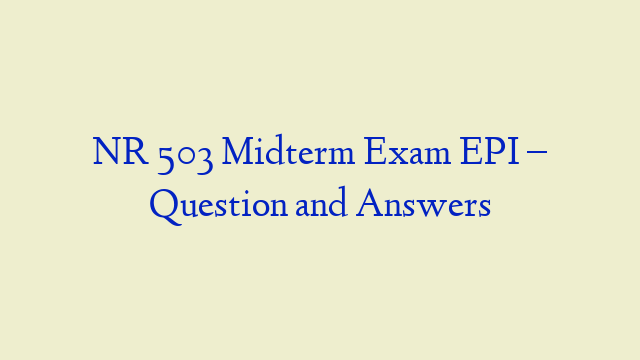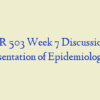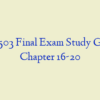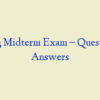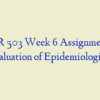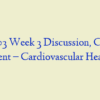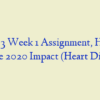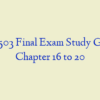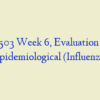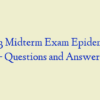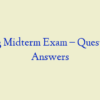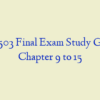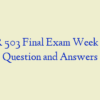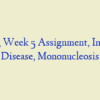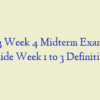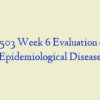Description
NR 503 Midterm Exam EPI – Question and Answers
- Which of the following statements best describe efficacy?
- A study is conducted for a pharmaceutical agent that has shown promise for reducing heart disease among women. In order to more fully test the agent, an additional study is done restricting the participants to be randomized to those who have a history of hypertension. Which of the following advantages cannot be claimed by the researchers?
- What is the main advantage of the randomization of the 168 study participants to one of the two drug treatment groups?
- After entry into the study, patients were first classified into three groups, those who had a previous AMI, those with a first AMI who were at high risk for other cardiovascular diseases such as congestive heart failure, and those with a first AMI who were at low risk for other cardiovascular diseases. Which term best describes the study design?
- After assignment to treatment group, 77% of those in the placebo group were men, while 80% of those in the drug X group were men. Which statement is most likely to be true?
- A preliminary analysis was conducted after 6 months and found that 87% of participants in the placebo group and 85% of those in the drug X group had taken more than 90% of their prescribed dosages. Which statement best describes this finding?
- Which of the following statements best describes the reason for conducting the study as a double-blind trial?
- A multicenter double-blind randomized study was carried out to compare the effect of drug X with that of a placebo in patients surviving acute myocardial infarction (AMI). Treatment with the drug started 7 days after infarction in 1,884 patients, 52% of all persons who were evaluated for entry into the study. 945 participants were randomized to treatment with drug X while 939 were assigned to the placebo group. Patients were then followed for 12 months for reinfarction. There were 152 deaths in the placebo group and 98 in the group receiving drug X.
- The following data come from a study of approaches to smoking cessation. Smokers who want to quit were randomized to one of four groups: control group C who received no intervention assistance, quitting guide group Q who received brochures about how to quit smoking, quitting guide and support group QS who received quitting brochures as well as social support brochures listing benefits of smoking cessation, and telephone support group T who received the brochures and a monthly phone call from a counselor. Participants received mailed surveys at 8, 16, and 24 months after randomization. The results after 2 years are in the table below. Which group had the least success in terms of quitting smoking?
- The following data come from a study of approaches to smoking cessation. Smokers who want to quit were randomized to one of four groups: control group C who received no intervention assistance, quitting guide group Q who received brochures about how to quit smoking, quitting guide and support group QS who received quitting brochures as well as social support brochures listing benefits of smoking cessation, and telephone support group T who received the brochures and a monthly phone call from a counselor. Participants received mailed surveys at 8, 16, and 24 months after randomization. The results after 2 years are in the table below. What is the main purpose of randomization in this study?
- A researcher is interested in the etiology of cervical cancer among women between 18 and 35 years of age. Her hypothesis concerns the influence of sexually transmitted diseases such as human papilloma virus (HPV) and subsequent development of cancer. What is the best study approach to address this hypothesis?
- Suppose that one third of all cervical cancer cases were smokers as were one third of all controls and smoking status is independent of HPV infection. Is smoking a potential confounder in this study?
- A case-control study was conducted to determine if an association exists between workers in uranium mines and loss of fertility due to reduced sperm count. A group of 200 men with low sperm count were identified from clinics located in areas with uranium mines. Each selected case was matched with a randomly selected male control on the following factors: race, age, area of residence, and smoking status. What is the purpose of matching?
- When incidence density sampling is used in a case-control study, which of the following is an important consideration?
- A recent prospective study on baldness and coronary heart disease (CHD) concluded that there was no association between the two, despite earlier cross-sectional studies which showed that baldness was associated with CHD when the two were determined at the same time in men. Which Bradford-Hill criterion is being tested by the newer study?
- A study examined the relation between use of estrogen replacement therapy (ERT) and ovarian cancer mortality using a prospective design. Of 24,231 eligible women, none had a prior history of cancer, hysterectomy, or ovarian surgery at enrollment in 1982. During 12 years of follow-up, 44 deaths from ovarian cancer occurred. In the published results, the authors note that 12,543 were excluded from the original cohort due to missing information for prior history variables. Which of the following is of greatest concern when interpreting the study results?
- A study examined the relation between use of estrogen replacement therapy (ERT) and ovarian cancer mortality using a prospective design. Of 24,231 eligible women, none had a prior history of cancer, hysterectomy, or ovarian surgery at enrollment in 1982. During 12 years of follow-up, 44 deaths from ovarian cancer occurred. In the published results, the authors note that 12,543 were excluded from the original cohort due to missing information for prior history variables.
- Age at menopause is a potential factor associated with use of ERT. The study investigators created three categories for age at menopause: less than 45 years, 46 through 54 years, and 55 years or more. After stratifying on age at menopause, the researchers reported relative risks of 0.97, 1.00 (referent), and 0.93 for each age group, respectively. Which of the following is true?
- A case-control study was conducted to assess whether occupational radiation exposure among men was associated with Down syndrome in their children. The investigators matched cases and controls on age of the mother at childbirth by 5-year categories. Why was this done?
- A case-control study was conducted to assess whether occupational radiation exposure among men was associated with Down syndrome in their children. The investigators matched cases and controls on age of the mother at childbirth by 5-year categories. When possible, information on paternal radiation exposure was taken from employment records rather than from subject interviews. Why was this done?
- An epidemiologist was interested in determining whether aspirin was associated with an increased risk of gastrointestinal (GI) bleeding. She relied on primary physicians to identify 600 patients at a hospital who were taking a daily dose of aspirin and 600 other patients who were not taking aspirin. Subjects were followed for 1 year to detect any occurrences of GI bleeding. Due to publicity about the risk of bleeding associated with aspirin, primary physicians treating patients at the hospital followed their patients who were taking aspirin more closely than they were unexposed subjects. Which of the following describes the impact that this may have on the epidemiologist’s study?
- Suppose that the study was repeated with a second physician who was responsible for verifying a diagnosis of GI bleeding in the patients. This physician was informed that all patients were using aspirin. If the likelihood of diagnosing the outcome among unexposed subjects was increased while all other diagnostic probabilities remained the same, what impact would this have on the bias?
- Matching is employed in a case-control study in order to ensure that:
- The effect of exposure to high-density automobile traffic either as a bicyclist or pedestrian was compared to minimal or no exposure to automobile traffic. It is hypothesized that direct exposure to automobile traffic has an effect on acute myocardial infarction (MI). This association was studied with 500 incident cases of MI diagnosed in the emergency rooms of several hospitals and compared to 1,000 other subjects who visited the same emergency rooms for reasons other than cardiovascular and respiratory diseases. All subjects were asked to report the amount of time that they spent exposed to high-density traffic over the past month prior to their hospital visit.
- Using the appropriate measure of association, as compared to the group with no traffic exposure, which of the following is a true statement concerning MI?
- Which of the following may explain the reason for the observed association?
- Which of the following is an advantage of the case-control study design?
- A large case-control study using multiple recruitment centers was conducted comparing 2,987 lung smoker cases to 3,013 other hospitalized persons selected as controls. One objective was to study the association between occupational exposure to chemicals and lung cancer. After compiling the data, the investigators noted that 90% of persons with lung cancer were smokers while 67% of the controls were smokers. The most practical and efficient way to eliminate differences between the cases and controls with regard to smoking would be to:
- An investigator is interested in studying the adverse effects of exposure to toxic metals on neurologic diseases such as Alzheimer’s disease. In assessing this risk, all of the following are important considerations for a prospective study design except:
- Why are controls needed in a case-control study?
- When is odds ratio obtained in a case-control study a reliable approximation of the relative risk for the general population?
- In a published epidemiologic study investigating infertility related to sexually transmitted diseases (STD), the authors state that 5% of identified cases refused enrollment, 10% of identified cases were lost to follow-up prior to data collection, and 10% of interviewed cases had missing data for one or more key variables describing exposure. Based on this information, which of the following statements is most likely to be true?
- In a published epidemiologic study investigating infertility related to sexually transmitted diseases (STD), the authors state that 5% of identified cases refused enrollment, 10% of identified cases were lost to follow-up prior to data collection, and 10% of interviewed cases had missing data for one or more key variables describing exposure. After data were gathered for the study, the investigators decided to restrict the analysis to women only, rather than including both men and women in the study. Assuming that sex is a confounder of the exposure–disease relationship under investigation, this decision would have which of the following effects?
- In the primary analysis of the study, the investigators measured exposure as a dichotomous variable (any history of STD compared to no history of STD). In subsequent analyses, the investigators looked at the relationship between specific STDs and infertility. They noted the following measures of association: for past history of gonorrhea, the odds ratio was 2.4 with a 95% confidence interval of 1.3 to 4.4. For past history of chlamydia, the odds ratio was 1.8 with a 95% confidence interval from 1.2 to 2.1. These results indicate that:
- If an investigator is analyzing the results of a clinical trial, then applying the “intention to treat” rule means that which type of bias is most likely to result?
- Investigators wanted to know if some military personnel are more error prone than others and would be a poor risk for training as a pilot. A study was done in which individuals who had injuries during basic training were compared to individuals who had not had an injury during training. Both groups were asked to recall episodes during childhood when they had had accidents that resulted in an injury. The individuals with a training injury reported more incidents during childhood when they had an injury. Therefore, the military command concluded that some persons are more likely to be error prone and that individuals with a childhood injury should be excluded from pilot training.
- One commanding officer disagreed with this conclusion. He asked the investigators to design a second study in which all individuals were asked about childhood injuries prior to the start of basic training. The group who reported having a childhood injury was compared to the group who had not had a childhood injury to determine which group had a higher rate of injuries during basic training. At the end of follow-up, there was no difference in the rate of injuries experienced by each group.
What type of design was used for the first study? - One commanding officer disagreed with this conclusion. He asked the investigators to design a second study in which all individuals were asked about childhood injuries prior to the start of basic training. The group who reported having a childhood injury was compared to the group who had not had a childhood injury to determine which group had a higher rate of injuries during basic training. At the end of follow-up, there was no difference in the rate of injuries experienced by each group.
What type of study design was used for the second study? - Which study better tests the hypothesis that there is a relationship between childhood injury and subsequent injury during basic training?
- Which of the following may explain why the two studies observed different results concerning the association between childhood injury and training injury?
- In a study of oral contraceptive (OC) use and hypertension, male interviewers for the study found a lower prevalence of OC use among participants than did female interviewers using the same questionnaire. Which term best describes this finding?
- A matched case-control study of sunscreen use during childhood and melanoma results in an odds ratio of 1.0. Cases of melanoma were matched by sex and race to controls who were identified by random digit dialing. What is the most likely explanation for the study’s null finding?
- Among patients with liver cancer, current alcohol drinkers have a worse prognosis for survival than nondrinkers. What would be the impact on the odds ratio for a case-control study of current alcohol use and liver cancer mortality if prevalent cases were included with incident cases of the cancer?
- In a case-control study of maternal cigarette smoking as a risk factor for low birth weight, the investigators concluded that mothers of children with low birth weight were more likely to report smoking during pregnancy relative to mothers of children with normal birth weight. The reporting error most likely caused the odds ratio to:
- In a case-control study of obesity and adult-onset asthma, controls are matched to cases on the basis of race and gender. This approach to selection is intended to decrease the influence of which type of bias?
- In a case-control study of computer display exposure and glaucoma, cases and controls were also asked about television watching habits. Errors in recall of exposure to video screens occurred with equal frequency among cases and controls. Which one of the following biases likely occurred?
- In a case-control study of computer display exposure and glaucoma, cases and controls were also asked about television watching habits. Errors in recall of exposure to video screens occurred with equal frequency among cases and controls. What is the most likely effect of this bias on the measure of association reported by the study?
- In a case-control study of computer display exposure and glaucoma, cases and controls were also asked about television watching habits. Errors in recall of exposure to video screens occurred with equal frequency among cases and controls. Which of the following methods for adjusting for confounding by age is most likely to affect the generalizability of the study findings?
- In a cohort study of occupational exposure to a chemical and subsequent incidence of bladder cancer, all workers who smoked were more likely to die of other causes before bladder cancer was diagnosed. What was the effect of this premature mortality on the measure of association reported by the study?
- Which of the following statements about person-years is not true?
- Test A has a sensitivity of 95% and a specificity of 90%. Test B has a sensitivity of 80% and a specificity of 98%. In a community of 10,000 people with 5% prevalence of the disease, Test A has always been given before Test B. What is the best reason for changing the order of the tests?
- This table represents the results of coronary magnetic resonance (CMR) angiography compared to x-ray angiography (the gold standard in diagnosis of coronary artery disease) in a high-risk population of patients scheduled to undergo x-ray angiography for suspected coronary artery disease.After reviewing the results of the test comparison, an epidemiologist decides that the specificity of the test is too low. Using the same CMR images, he raises the cutoff value for a positive test to increase the specificity. What is the likely effect on the sensitivity?
- In comparing the mammography readings of two technicians who evaluated the same set of 600 mammograms for presence of breast cancer from a generally representative sample of women from the population,
- In a country with a population of 16 million people, 175,000 deaths occurred during the year ending December 31, 2005. These included 45,000 deaths from tuberculosis (TB) in 135,000 persons who were sick with TB. Assume that the population remained constant throughout the year. Not all 135,000 cases of TB were contracted during 2005. Which of the following statements is true?
- Which of the following statements pertains to relative survival?
- An important assumption in this type of analysis is that:
- Before reporting the results of this survival analysis, the investigators compared baseline characteristics of the 38 people who withdrew from the study before its end to those who had complete follow-up. This was done for which of the following reasons:
- Which of the following is a key assumption involved in the use of life-table analysis?
- Which of the following is a measure of disease prognosis?
- In 2003, Sudden Acute Respiratory Syndrome (SARS) appeared in several countries, mainly in Asia. The disease was determined to have been caused by a virus that could be spread from person –to person from the index case occurring in mainland China. This table reflects the total number of reported cases of SARS and deaths among those cases as best as can be determined. Based on the table, we can conclude that the case-fatality rate (CFR) in Vietnam:
- In 2003, Sudden Acute Respiratory Syndrome (SARS) appeared in several countries, mainly in Asia. The disease was determined to have been caused by a virus that could be spread from person –to person from the index case occurring in mainland China. This table reflects the total number of reported cases of SARS and deaths among those cases as best as can be determined. Following a revision in the case definition, more persons were found to have suffered from an infection with the SARS virus. The inclusion of these cases, almost all asymptomatic, did not impact the total number of SARS fatalities. What happened to the case-fatality rate (CFR) following this reclassification?
- Before reporting the results of this survival analysis, the investigators compared baseline characteristics of the 44 people who withdrew from the study before its end to those who had complete follow-up. This was done:
